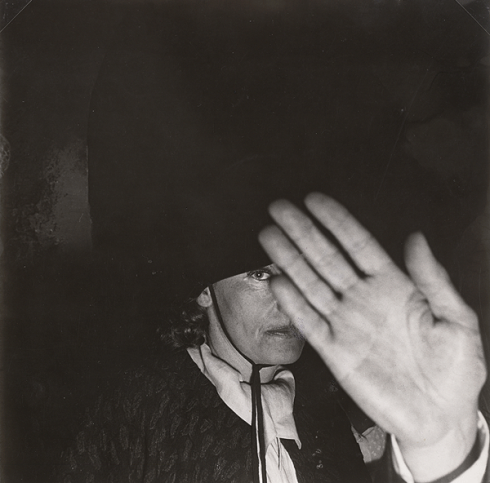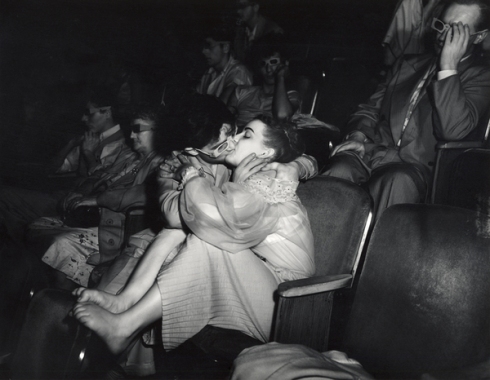at the Tate Modern 28 May – 3 October 2010
Exposed: Voyeurism, Surveillance and the Camera surveys voyeuristic photography from the 19th Century until the present day, juxtaposing images from both famous and amateur photographers. The theme of voyeurism is covered by undercover, paparazzi and salacious photography, but also stark images of death, execution and war.
If you can’t make it to the exhibition you can still order the catalogue, available here: Amazon UK / Amazon US. Be warned that the book contains some disturbing imagery beyond what is featured in the exhibition.
Here I will be taking a brief closer look at five works found in the show.
1. Greta Garbo in the Club St. Germain, Paris (Georges Dudognon, circa 1950s) [San Francisco Museum of Modern Art, Members of Foto Forum, 2005.200 © Estate of Georges Dudognon]

The face in the paparazzi image above is actually The Face: Greta Garbo. One of the most famous and admired women in the world, Garbo became a New York recluse after retiring from films at the beginning of the 1940s. Sightings of her were rare, and this 1950s image captures the conflict between a movie star’s public persona and private life. Now older and with her face obscured, Garbo is unrecognisable, but once understood to be her it becomes a contrasting reference to all those images of her as an icon of beauty and stardom. It is also perfectly composed: notice how Garbo’s eye is perfectly in focus yet the hand is not, and how her eye fits perfectly between the end of the little finger and the brim of her hat. It is one of those miraculous images that appear to be both a product of chance and a skillful photographer.
2. Lovers with 3-D glasses at the Palace Theatre (Infra-red) (Weegee [aka Arthur Fellig], 1943)

Image co. of: http://www.rachelhulin.com/blog/2009/09/ten-from-weegee-and-amber-online.html
Weegee was a crime photographer who was always in the right place at the right time, stealing striking to-the-point images of violence, chaos and murder on the streets of New York. He also took shot of city life more widely, including several fascinating shots of audiences in movie theatres. These often focused on kissing couples in the crowd, oblivious to the movie on the screen. These images (some of which I believe were actually staged, with couples brought into the cinema) hint at the love-in-the-dark culture that had been prevalent in cinema-going from its earliest days. One of these images actually takes place in the midst of a 3D movie, the audience bespectacled in their green-and-red paper spectacles. Some of the audience look entertained, but the kissing couple appears to be bored. (Maybe they’re readers of The Classic Film Show.)
The above image would have required a pretty powerful flash to light the scene, surely a major distraction to the movie.
Further images by Weegee can be viewed online here. http://www.amber-online.com/exhibitions/weegee-collection
He also took this fascinating, candid photograph of Marilyn, skirt lifted, on the location set of The Seven Year Itch.

Image co. of: http://www.tate.org.uk/modern/exhibitions/exposure/theme2.shtm
3. Many Are Called (Walker Evans)

Image co. of: http://visualingual.wordpress.com/2008/12/30/subway-portraits-by-walker-evans/
A famous series of images by Walker Evans shows portraits of unsuspecting travellers on the New York subway. To capture commuters unaware, Evans made these images covertly using a hidden camera stowed away in his coat, only really made possible by the greater portability and low-light capabilities of modern cameras. What resulted were unselfconscious images of daily New York life, and what is life in the city but a series of arduous journeys back and forth?
This series is available in a quality hardback by the Museum of Modern Art, (Amazon.com / Amazon.co.uk) which will surely become a collector’s item pretty soon.
4. Hyères, France 1932, Henri Cartier-Bresson

Image co. of: http://loinsbongo.blog.co.uk/2009/10/28/la-vie-en-noir-et-blanc-7264520/
The exhibition contains some of the most famous images in photography, including this Cartier-Bresson image of a bicycle captured perfectly within the limited space of the composition. It is often claimed that Cartier-Bresson took the most perfect snapshot, an image that crystalised ‘the defining moment’, in Behind the Gare St. Lazare, Paris. In the above image Cartier-Bresson found his composition in the twisting lines of the bannisters but waited for something to fill the space. When a bicycle came along he clicked at the above moment. Spontaneity in photography can be a difficult effect to achieve.
5. Sophie Calle – The Shadow
Sophie Calle is a French artist who came to prominence in the 1970s with her combination of text and photography in her art-as-life narratives. She took elements of detective fiction and connected them to her real life. In one project presented by the exhibition, she asked a private detective to tail her and send her a report, in essence following herself. It’s a piece that would resonate with anyone familiar with noir movies or the nouvelle vague and is a storyline that would fit well in a postmodern noir tale.
But there are also some truly chilling and disturbing images: a body falls from a hotel window in a desperate escape from a fire; a suicidal man jumps from a bridge after the crowd below collectively encourage him; the decayed remains of a victim of the Rwandan genocide has sunk into the earth.
Elsewhere in the exhibition are works by famous photographers such as Paul Strand, Garry Winogrand and Dorothea Lange and as a whole provides an overview of the entire medium of photography.
Again the catalogue is available here (Amazon UK / Amazon US).
More information about the exhibition, which runs until 3rd October 2010, can be found at the Tate Modern website.




1 comment
Comments feed for this article
July 22, 2010 at 7:32 pm
jamie
Just wanted to note Weegee didn’t use a flash in his nighttime/darkness photography, instead shooting in infrared to capture the image and leave the subjects unaware of the fact that they were being photographed. Same stuff as his photography of the beach lovers. Kinda adds to the voyeuristic aspect, no?